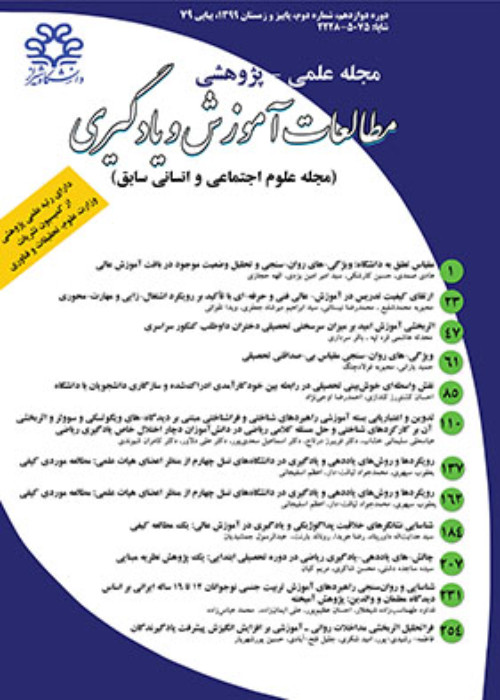Testing a Model of Family Communication Pattern and Attitude toward Creativity with Regard to the Mediating Role of Academic Motivation
Author(s):
Article Type:
Research/Original Article (دارای رتبه معتبر)
Abstract:
Introduction In psychological literature there are many definitions of creativity, some definitions focus on products of creativity and others emphasize the process of creativity. Nevertheless, the productions of an idea that are novel and appropriate are usually accepted as a core characteristic of creativity. In the case of factors associated with creativity, studies have shown that family, community, attitudes, personality, motivation etc
have an impact on creativity or attitude toward it. According to some research warm and eager parents that make fixed boundaries, promote creativity in children. It is known that family is the strongest variable that influence creativity. Dimensions of family communication patterns are one of the important structures in family psychology that effect the creativity among children. Family communication patterns have two dimensions namely dialogue and confirmatory dimensions. In the case of family communication patterns and creativity, researches confirmed that dialogue dimension is the positive predictor and conformity is the negative predictor of creativity. In addition, research findings showed that selfdetermination especially intrinsic motivation is an important variable that have an effect on creativity. Deci and Ryan (2000) and Amobile (1996, 2001) believed that contextual variables and autonomous motivation are also very important to nurture creativity. The context that we live in is important variable. Parents are one of the important contextual factors to creativity. Parents can provide autonomy support, structure, and involvement. Autonomy support from parents refers to parents providing rationale, giving choices, and acknowledging children feelings during childhood (Baard et al., 2004). The researchers showed that dialogue in family affects the intrinsic motivation and consequently affects creativity. Although the previous studies have strongly confirmed the positive relationships of family variables and creativity, they did not clearly mention the mechanism of these relationships. The present study aimed to expand the previous research regarding the relationship between contextual factors, academic motivation and attitude toward creativity. In particular it has investigated the mediating role of academic motivation in the relationship between family communication pattern and creativity. So, this study attempted to answer the following research questions: 1- Is there a relationship between family communication pattern and creativity? 2- Is there a relationship between family communication pattern and academic motivation? 3- Does academic motivation have a mediation role between family communication pattern and creativity?
Method The research was a correlational study that was conducted among high school students in Aligodarz. The sample comprised 328 students (145 male and 183 female) from senior high school (grades 10 to 12) who were selected by cluster sampling method. Their ages ranged from 15 to 20 years. The participants responded to the following scales: Family communication patterns scale, Situational motivational scale, and Creativity assessment Scale. These instruments showed appropriate reliability and validity. Path analysis was the major statistical operation in the study.
Results The results of path analysis showed that the relationship between family communication pattern and creativity was influenced by the academic motivation. Confirmatory dimension of family communication pattern had negative direct and indirect effects on creativity while extrinsic motivation, dialogue dimension of family Communication pattern had positive direct and indirect effects on creativity. In sum, the results showed that academic motivational beliefs could be a mediator in family communication pattern and creativity. To evaluate the model, multiple indices of fitness were used which indicated that there was an acceptable fitness between the models and data.
Discussion The main goal of this study was to investigate the relationship between family communication pattern and creativity with the mediating role of academic motivation. Data analysis showed that model variables explained 0.34 of the attitude toward creativity variance. Examining direct, indirect and total causal effects of the final model showed that dimensions of family communication patterns predicted attitude toward creativity with the mediating role of academic motivation. Combination of the variables in this model is, by itself, the most significant characteristic of this research. This finding that motivation plays a significant role in the relationship between family communication patterns and attitude toward creativity has illuminated the nature of this relation. Also it was revealed that student's creativity is, to some degree, affected by their academic motivation; those with an intrinsic motivation had more creativity than those with an extrinsic motivation. The findings indicate that if family environment provides comfortable conditions for conversation about many topics and spend much time to express thoughts and feelings of family members, the intrinsic motivation will be increased and will result in student's creativity. The findings could also be useful for schools; schools are expected to train communication and social life skills and values. Schools may help students to train needed skills for expressing feelings and emotions. Finally, in association with research proposals and constraints it can be said that, given the limited scope of the study participants in terms of age and geography, it is necessary to take care in generalizing the results to other regions and age groups. Also, as the study is correlational, causal inference is not possible from the results.
Method The research was a correlational study that was conducted among high school students in Aligodarz. The sample comprised 328 students (145 male and 183 female) from senior high school (grades 10 to 12) who were selected by cluster sampling method. Their ages ranged from 15 to 20 years. The participants responded to the following scales: Family communication patterns scale, Situational motivational scale, and Creativity assessment Scale. These instruments showed appropriate reliability and validity. Path analysis was the major statistical operation in the study.
Results The results of path analysis showed that the relationship between family communication pattern and creativity was influenced by the academic motivation. Confirmatory dimension of family communication pattern had negative direct and indirect effects on creativity while extrinsic motivation, dialogue dimension of family Communication pattern had positive direct and indirect effects on creativity. In sum, the results showed that academic motivational beliefs could be a mediator in family communication pattern and creativity. To evaluate the model, multiple indices of fitness were used which indicated that there was an acceptable fitness between the models and data.
Discussion The main goal of this study was to investigate the relationship between family communication pattern and creativity with the mediating role of academic motivation. Data analysis showed that model variables explained 0.34 of the attitude toward creativity variance. Examining direct, indirect and total causal effects of the final model showed that dimensions of family communication patterns predicted attitude toward creativity with the mediating role of academic motivation. Combination of the variables in this model is, by itself, the most significant characteristic of this research. This finding that motivation plays a significant role in the relationship between family communication patterns and attitude toward creativity has illuminated the nature of this relation. Also it was revealed that student's creativity is, to some degree, affected by their academic motivation; those with an intrinsic motivation had more creativity than those with an extrinsic motivation. The findings indicate that if family environment provides comfortable conditions for conversation about many topics and spend much time to express thoughts and feelings of family members, the intrinsic motivation will be increased and will result in student's creativity. The findings could also be useful for schools; schools are expected to train communication and social life skills and values. Schools may help students to train needed skills for expressing feelings and emotions. Finally, in association with research proposals and constraints it can be said that, given the limited scope of the study participants in terms of age and geography, it is necessary to take care in generalizing the results to other regions and age groups. Also, as the study is correlational, causal inference is not possible from the results.
Keywords:
Language:
Persian
Published:
Studies in Learning & Instruction, Volume:9 Issue: 2, 2018
Pages:
105 to 121
magiran.com/p1809124
دانلود و مطالعه متن این مقاله با یکی از روشهای زیر امکان پذیر است:
اشتراک شخصی
با عضویت و پرداخت آنلاین حق اشتراک یکساله به مبلغ 1,390,000ريال میتوانید 70 عنوان مطلب دانلود کنید!
اشتراک سازمانی
به کتابخانه دانشگاه یا محل کار خود پیشنهاد کنید تا اشتراک سازمانی این پایگاه را برای دسترسی نامحدود همه کاربران به متن مطالب تهیه نمایند!
توجه!
- حق عضویت دریافتی صرف حمایت از نشریات عضو و نگهداری، تکمیل و توسعه مگیران میشود.
- پرداخت حق اشتراک و دانلود مقالات اجازه بازنشر آن در سایر رسانههای چاپی و دیجیتال را به کاربر نمیدهد.
دسترسی سراسری کاربران دانشگاه پیام نور!
اعضای هیئت علمی و دانشجویان دانشگاه پیام نور در سراسر کشور، در صورت ثبت نام با ایمیل دانشگاهی، تا پایان فروردین ماه 1403 به مقالات سایت دسترسی خواهند داشت!
In order to view content subscription is required
Personal subscription
Subscribe magiran.com for 70 € euros via PayPal and download 70 articles during a year.
Organization subscription
Please contact us to subscribe your university or library for unlimited access!



